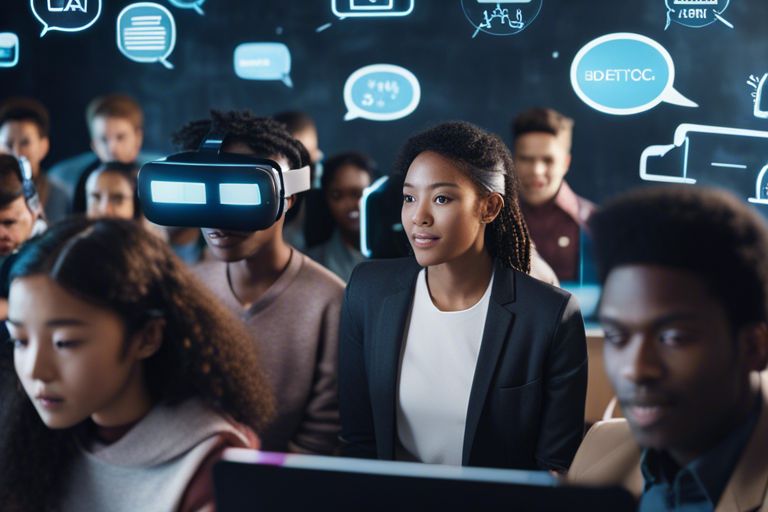With the rapid advancement of technology, AI language translation tools are revolutionizing the way we break through linguistic barriers in education. These groundbreaking tools are not only making learning more accessible to multilingual students but also expanding opportunities for international collaboration among educators and researchers. Let’s explore into how these AI-powered solutions are transforming the landscape of education and creating a more inclusive learning environment for all.
The Language Barrier in Education
To effectively communicate and learn, language plays a crucial role in the education sector. In a diverse classroom setting, students from different linguistic backgrounds can face hurdles in understanding lessons, expressing themselves, and engaging with their peers and teachers. This language barrier can hinder the educational experience and impact students’ learning outcomes.
The Challenges of Multilingual Classrooms
An evident challenge in multilingual classrooms is the difficulty in ensuring that each student comprehends the subject matter equally. Teachers may struggle to deliver instructions that cater to every student’s linguistic needs, leading to disparities in understanding and participation. Additionally, students may feel isolated or marginalized if they are unable to fully express themselves or communicate with their peers due to language differences.
The Impact on Student Learning Outcomes
The language barrier in education can have a profound impact on student learning outcomes. Students who face language challenges may experience lower academic performance, decreased confidence, and a lack of motivation to actively engage in class activities. Furthermore, the inability to fully grasp educational material can impede students’ holistic development and limit their future prospects in higher education and the job market.
This highlights the urgent need for effective solutions to break down language barriers in education and create inclusive learning environments that support the diverse linguistic needs of students.
The Rise of AI Language Translation Tools
Some of the most groundbreaking advancements in technology today are in the field of artificial intelligence (AI) language translation tools. These tools have revolutionized the way we communicate across different languages, breaking down barriers and enabling seamless interaction on a global scale. AI language translation tools have significantly improved over the years, making them more accurate, efficient, and user-friendly.
The Evolution of Machine Translation
Evolution in machine translation has been a journey marked by continuous improvement and innovation. From the early days of rule-based systems to statistical methods, and now to the era of neural machine translation (NMT), the accuracy and fluency of translations have seen remarkable enhancements. The incorporation of deep learning algorithms has allowed these systems to better understand context, idiomatic expressions, and nuances in language, resulting in more natural and reliable translations.
The Advent of Artificial Intelligence in Language Translation
One of the key milestones in the advancement of AI language translation tools has been the integration of artificial intelligence. AI algorithms, particularly those based on deep learning and neural networks, have enabled translation systems to learn and improve from vast amounts of data. This has led to significant improvements in translation quality, with the ability to handle complex sentence structures and dialects. These AI-powered tools have not only sped up the translation process but also enhanced the overall accuracy of the output, making them indispensable in various fields, including education.
Benefits of AI Language Translation Tools in Education
Increased Accessibility for Language Minority Students
Students today come from diverse linguistic backgrounds, and for those who are language minority students, traditional language barriers can hinder their learning and academic success. AI language translation tools play a crucial role in breaking down these barriers by providing real-time translation services in classrooms. This ensures that all students have equal opportunities to engage with the learning material and participate actively in discussions, regardless of their native language.
Enhanced Communication Between Teachers and Students
Increased accessibility to AI language translation tools fosters enhanced communication between teachers and students who may not share the same primary language. This enables teachers to provide more personalized support and feedback to their students, bridging the gap that language differences might create. Additionally, students feel more confident in expressing their thoughts and asking questions when they know that language translation tools are available to facilitate clear communication.
Breaking Down Cultural Barriers
Not only do AI language translation tools help break down language barriers, but they also play a crucial role in bridging cultural gaps in educational settings. When students are able to communicate effectively in their native language, they are more likely to preserve their cultural identity and heritage.
Preserving Cultural Identity Through Language
Identity is closely intertwined with language, and being able to express thoughts and ideas in one’s mother tongue is imperative for maintaining cultural identity. AI translation tools enable students to engage with educational material in their own language, ensuring that they do not have to compromise their cultural heritage for the sake of education.
Fostering Cross-Cultural Understanding in the Classroom
CrossCultural interactions in the classroom can lead to a deeper understanding and appreciation of diverse cultures. AI language translation tools facilitate communication between students from different cultural backgrounds, fostering an environment of mutual respect and understanding.
Fostering cross-cultural understanding in the classroom not only enriches the educational experience but also prepares students to thrive in an increasingly interconnected and diverse world.
The Role of AI in Language Learning
Personalized Language Instruction
Unlike traditional classroom settings, AI in language learning offers personalized instruction tailored to individual needs. Language AI tools can analyze a student’s strengths and weaknesses, adjusting lessons accordingly to optimize learning outcomes. By recognizing each learner’s unique pace and style, AI enhances engagement and retention, making the learning process more efficient and effective.
Real-time Feedback and Assessment
For students, one of the key benefits of AI-driven language learning is the provision of real-time feedback and assessment. Language AI tools can instantly evaluate pronunciation, grammar, vocabulary usage, and more, providing immediate guidance for improvement. This constant feedback loop accelerates learning progress and helps students track their development over time.
Learning a new language can be daunting, but with AI tools offering personalized instruction and real-time feedback, students can enjoy a more interactive and efficient learning experience. The ability to receive instant corrections and guidance enhances student confidence and motivation, leading to accelerated language acquisition.
Overcoming the Limitations of Human Translation
The Shortcomings of Human Interpreters
Limitations: Human interpreters, while skilled and proficient in multiple languages, are still susceptible to human error. Misinterpretations, lack of context understanding, and fatigue can all contribute to inaccuracies in translation. Additionally, the availability and cost of qualified human interpreters can pose challenges for educational institutions looking to provide multilingual support.
The Advantages of AI-Powered Translation
Translation: AI-powered translation tools offer a solution to many of the challenges faced by human interpreters. These tools can quickly and accurately translate large volumes of text, taking into account context and nuances that may be missed by humans. AI-powered translation tools are available 24/7, providing immediate and cost-effective language support to students and educators.
Implementing AI Language Translation Tools in the Classroom
Integrating AI Translation into Lesson Plans
Not only do AI language translation tools break down language barriers, but they also offer unique opportunities for educators to enhance their teaching methods. Integrating these tools into lesson plans can help students grasp complex concepts more effectively. By providing translations in real-time, teachers can cater to the diverse linguistic needs of their students, ensuring that no one is left behind due to language constraints.
AI translation tools can simplify the learning process by allowing students to access information in their preferred language. This can lead to increased engagement and comprehension, ultimately improving academic performance across the board.
Training Teachers to Effectively Use AI Tools
Any successful implementation of AI language translation tools in the classroom requires proper training for teachers. It is necessary to equip educators with the knowledge and skills to effectively integrate these tools into their teaching practices. By providing training sessions and workshops, teachers can learn how to leverage AI translation tools to create inclusive learning environments where language is no longer a barrier to education.
Training teachers to harness the power of AI translation tools not only ensures that students receive quality education regardless of their language background but also fosters a more inclusive and diverse classroom where all students can thrive.
Addressing Concerns and Challenges
Many advancements in AI language translation tools have greatly improved the accessibility of education for students worldwide. However, there are concerns regarding the accuracy and reliability of these tools in academic settings.
Ensuring Accuracy and Reliability of AI Translations
Any educational institution utilizing AI language translation tools must prioritize ensuring the accuracy and reliability of the translations provided. It is crucial to regularly assess the quality of translations and address any errors or inconsistencies promptly. This can be achieved through a combination of human oversight and continuous feedback loops to refine the algorithms used by these tools.
Mitigating the Risk of Over-Reliance on Technology
Many educators worry about the potential risk of over-reliance on AI language translation tools in the classroom. While these tools are incredibly useful, there is a danger of students becoming dependent on them and neglecting to develop their language skills organically.
Reliability is imperative in ensuring that students continue to actively engage with and practice the language they are learning, instead of relying solely on technological aids.
Technology should be seen as a complement to traditional language learning methods, rather than a replacement. Educators play a vital role in guiding students on how to effectively use AI translation tools as supplementary aids while also emphasizing the importance of developing their language proficiency through practice and immersion.

The Future of Language Education
Once again, the landscape of language education is evolving with the advent of AI language translation tools. The future of language education is being shaped by the integration of these advanced technologies, offering both challenges and opportunities for educators and students alike.
The Potential for AI-Driven Language Learning Platforms
For language learners, AI-driven language learning platforms present a world of possibilities. These tools have the potential to provide personalized learning experiences, adapt to individual learning styles, and offer real-time feedback. Students can benefit from interactive exercises, virtual language tutors, and immersive simulations that enhance their language skills in ways traditional methods cannot.
The Implications for Teacher Training and Development
Potential changes to language education brought about by AI technology also extend to teacher training and development. Educators may need to adapt their teaching methods to incorporate these new tools effectively. Training programs could include workshops on utilizing AI in the classroom, understanding analytics generated by these platforms, and fostering a collaborative learning environment that combines technology with traditional teaching methods.
A shift towards AI-driven language education highlights the importance of ongoing professional development for teachers to stay abreast of the latest trends in education technology. With proper training and support, educators can harness the power of AI tools to enhance their teaching practices and better serve the needs of their students.
Real-World Applications and Success Stories
AI-Powered Translation in Bilingual Education
Success: AI language translation tools have revolutionized bilingual education by breaking down language barriers and promoting inclusivity in the classroom. One such success story comes from a school in California where students from diverse linguistic backgrounds are excelling in their studies with the help of AI translation tools. These tools enable students to easily understand lectures, participate in discussions, and complete assignments in their preferred language, fostering a more conducive learning environment.
Language Translation Tools in Special Education
Success: In special education, AI language translation tools have played a vital role in improving communication and learning outcomes for students with language delays or disabilities. By translating instructions, resources, and feedback into various languages or formats, these tools empower students to fully engage with educational content and participate in classroom activities, regardless of their linguistic challenges.
Translation: These language translation tools not only enhance classroom interactions but also facilitate better collaboration among teachers, parents, and support staff. By ensuring that all stakeholders can effectively communicate and collaborate, these tools contribute to a more inclusive and supportive educational environment for students with special needs.
The Ethics of AI Language Translation in Education
Balancing Technology with Human Interaction
With the advent of AI language translation tools in education, there arises a crucial need to balance technology with human interaction. While these tools undoubtedly enhance communication and understanding across languages, it is crucial not to overlook the importance of genuine human connection in the learning process. Students benefit not only from language translation but also from the nuances, emotions, and cultural context that human teachers bring to the table. Striking a balance between AI-driven translation and human interaction is key to creating a holistic and enriching educational experience.
Ensuring Equity and Fairness in AI-Driven Education
One of the pressing ethical considerations in the use of AI language translation in education is ensuring equity and fairness for all students. It is crucial to address issues of access and affordability to these tools, as well as to consider the potential biases that AI algorithms may introduce. Ensuring that all students, regardless of their background or location, have equal opportunities to benefit from AI language translation tools is paramount in creating an inclusive educational landscape.
Understanding the implications of relying solely on AI-driven translation in education is crucial for educators and policymakers. While AI tools can greatly enhance language learning and cross-cultural communication, careful consideration must be given to the potential consequences of over-reliance on technology. Ensuring that students have a well-rounded educational experience that combines AI translation with human interaction is crucial for fostering a truly enriching and equitable learning environment.
The Economic Impact of AI Language Translation Tools
Reducing Costs Associated with Human Interpretation
Economic considerations play a significant role in the integration of AI language translation tools in various sectors, including education. By leveraging AI technology for language translation, educational institutions can significantly reduce costs associated with hiring human interpreters for multilingual communication needs. The use of AI tools not only offers a more cost-effective solution but also ensures quicker and more accurate translations, thereby enhancing overall operational efficiency.
Investing in AI-Driven Language Education Infrastructure
Impact of investing in AI-driven language education infrastructure is profound. Institutions that embrace AI language translation tools are better positioned to provide high-quality education to a diverse student population. By investing in these technologies, educational institutions can create a more inclusive learning environment where language barriers are minimized. Additionally, the integration of AI tools can empower educators to deliver personalized learning experiences tailored to individual student needs, fostering academic success and engagement in the classroom.
With advancements in AI technology, institutions can develop AI-driven language education platforms that offer students access to real-time translations, language learning resources, and interactive learning activities. By incorporating these tools into the educational infrastructure, institutions can enhance language learning outcomes and better prepare students for success in an increasingly globalized and multilingual world.
The Road Ahead
Advancements in AI Language Translation Technology
After exploring the current landscape of AI language translation tools in education, it’s evident that we are on the cusp of significant advancements in this technology. Machine learning algorithms are becoming more sophisticated, allowing for greater accuracy and precision in translation. With the help of neural networks and deep learning, AI translation tools are improving at a rapid pace, offering users a more seamless and natural language experience.
The Need for Ongoing Research and Development
Ahead of us lies a future where AI language translation tools will play an increasingly vital role in breaking down language barriers in education. Continuous research and development in this field are crucial to ensure that these tools evolve to meet the diverse needs of learners worldwide. Interdisciplinary collaborations between linguists, computer scientists, and educators will be important in pushing the boundaries of AI language translation technology.
Language is a dynamic and complex system, and as such, there is no one-size-fits-all solution when it comes to translation. Ongoing research and development will be necessary to address the nuances of different languages, dialects, and cultural contexts to enhance the efficacy of AI language translation tools in educational settings.
Plus, with the increasing integration of AI language translation tools in classrooms worldwide, it is vital to prioritize data privacy and security measures to protect sensitive information and ensure the ethical use of technology in education.
1. AI translation tools enhance communication for non-native language learners.
2. Improve accessibility to educational resources in different languages.
3. Foster cross-cultural understanding and diversity in the classroom.
4. Boost participation and engagement in multilingual environments.
5. Enhance language learning and acquisition through real-time translations.
6. Facilitate collaboration and global connections in educational settings.
Final Words
Hence, with the rapid advancements in AI language translation tools, educators can now break language barriers and provide a more inclusive learning environment for students from diverse linguistic backgrounds. These tools not only facilitate communication between teachers and students who speak different languages but also open up a world of educational resources that were previously inaccessible due to language constraints.
In short, integrating AI language translation tools into educational settings has the potential to revolutionize the way we teach and learn, leveling the playing field for all students regardless of their native language. By embracing these innovative technologies, we can foster a more collaborative and globally connected learning experience that prepares students for success in an increasingly multicultural world.
FAQ
Q: What are AI language translation tools in education?
A: AI language translation tools in education are software applications that use artificial intelligence to translate text or speech from one language to another, helping students and educators overcome language barriers in the learning process.
Q: How do AI language translation tools work?
A: AI language translation tools work by analyzing the input text or speech using machine learning algorithms to understand the context and meaning, and then generating an accurate translation in the desired language.
Q: What are the benefits of using AI language translation tools in education?
A: Using AI language translation tools in education can help students access educational resources in different languages, improve communication between students and educators who speak different languages, and facilitate cross-cultural learning experiences.
Q: Are AI language translation tools accurate?
A: AI language translation tools have made significant advancements in accuracy over the years, thanks to advancements in natural language processing and machine learning technologies. While they may not be perfect, they can provide reliable translations for educational purposes.
Q: How can educators integrate AI language translation tools into the classroom?
A: Educators can integrate AI language translation tools into the classroom by using them to translate educational materials, facilitate communication with non-native speakers, and create multilingual learning environments that cater to diverse student populations.
Q: What are some popular AI language translation tools used in education?
A: Some popular AI language translation tools used in education include Google Translate, Microsoft Translator, and Babylon Translator. These tools offer a range of features and language support to meet the needs of students and educators worldwide.
Q: What does the future hold for AI language translation tools in education?
A: The future of AI language translation tools in education looks promising, with ongoing advancements in AI technology improving accuracy, speed, and language support. These tools have the potential to revolutionize global education by breaking down language barriers and promoting cross-cultural exchange in learning environments.




